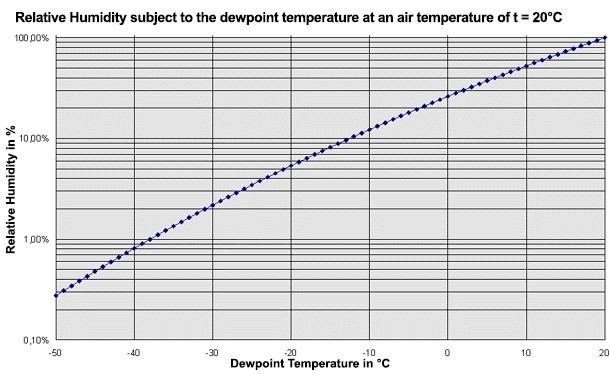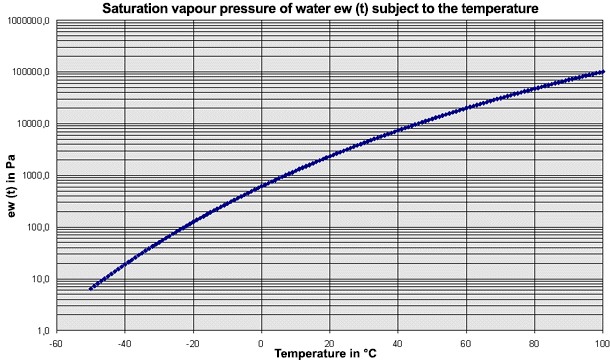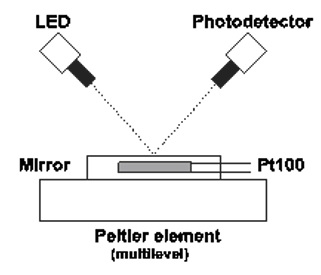
humidity
general information
relative humidity (unit %)
Relative humidity is the ratio of the mass of water vapour actually present in the air to the maximum possible mass of water vapour in the air. Relative humidity is usually expressed in percent.
It applies:

Note: Since maximum humidity is dependent on temperature, relative humidity changes with temperature, even when absolute humidity remains constant.

absolute humidity (unit g/m3)
Absoluter humidity fabs refers to the volume of water vapour actually present in a specific quantity of air. Absolute humidity is the ratio of the weight of the water contained in the air to the volume of this moist air.
water vapour partial pressure, saturation vapour pressure (unit hPa)
Saturation vapour pressure es(t) is the maximum possible pressure of water vapour at a certain temperature. The saturation vapour pressure of water dependent on temperature is presented in the chart below. The water vapour partial pressure e(t) varies between 0 (dry air) and 30 hPa. The saturation vapour pressure determines the upper limit.

saturation humidity, maximum humidity, saturation quantity (unit g/m3)
Maximum humidity fmax is the maximum possible water vapour quantity in one cubic meter of air at a certain temperature. The moisture absorption capacity of air increases with increasing temperature. If maximum humidity is exceeded, the excess water vapour condenses in the form of condensate (droplet formation).
dew point (unit °C, °F, K)
Dew point temperature ttp is the temperature at which the cooling of moist air leads to condensate formulation. This means that when moist air is cooled down to dewpoint the relative humidity rises to 100 %.
frost point (unit °C, °F, K)
In some cases where dewpoint temperatures are below 0°C we refer to the frost point temperature. Other descriptions are also dewpoint temperature above ice or freezing point.
specific enthalpy (heat content) (unit kJ/kg)
Specific enthalpy Espez refers to the quantity of heat that is necessary to raise the temperature of a gas (or gas mixture) from one temperature to another at constant pressure.
Or:
Specific enthalpy refers to the quantity of heat that is present in the air mass relative to a certain air condition. The enthalpy of the unsaturated air is the sum of the enthalpy to vaporise the contained water content plus the enthalpy to heat the water vapour mixture to the corresponding temperature.
mixing ratio (unit g/kg)
Mixing ratio m is the ratio of water vapour mass to the mass of dry air.
wet bulb temperature (unit °C, °F, K)
Wet bulb temperature tF in psychrometric measurement is the temperature that is ouput or indicated by a thermometer wrapped in a moist sock. Due to the cooling by evaporation this temperature dependent on the relative humidity lies below the air temperature.
sensors and measurement principles
mechanical humidity measurement
The mechanical procedure is based on the expansion and contraction of various (mostly organic) measuring elements. Such measuring elements are, for example: hair, durometers, gut strings, etc.
The measuring elements mostly used are hair elements or the so-called Durotherm, an artificial, humidity-sensitive measuring element. The change in length of the measuring element is transferred to the indicator by means of a mechanism.
Hair hygrometers require regular service and maintenance. To avoid drying-out and associated drift, hair hygrometers must be regularly regenerated. o do this, the hair harp is wrapped in a cloth moistened with distilled water, or sprayed with distilled water, such that saturation occurs. After approximately one hour a measurement value of ca. 98 %RH is obtained. A single point adjustment can be carried out on most units using an adjustment screw.
psychrometric humidity measurement
Psychrometers operate with two identical, very accurate thermometers, along which the air to be measured is led at a defined speed or over which the air is stationary.
The first thermometer measures the ambient air, the second the so-called wet bulb temperature. For this purpose the measurement tip of the thermometer is covered by a cotton wick and moistened with distilled water. Both thermometers are placed in an airflow or in still air and are protected from radiant heat. Due to the cooling by evaporation the temperature of the wet thermometer falls, the more the dryer the air is. After a short time (1 - 2 min) the temperature of the wet thermometer remains constant and the measurement values of the wet and dry thermometers can be read. With these two temperatures the relative humiditycan be determined in accordance with the following formula:

where A is the so-called psychrometer constant. This depends on the air velocity and is presented in the table below:
| ventilation speed | 0.0 | 1.0 | 1.5 | 2.3 | 3.4 | 4.4 | [m/s] |
| A: 106 in degrees-1 | 1,140 | 675 | 674 | 678 | 682 | 704 |
electronic humidity measurement
capacitive procedure
The humidity-sensitive condenser consists of two flat electrodes, between which is located an electrically isolating, hygroscopic synthetic coating (dielectric). This dielectric can absorb the water present in the air. With increasing air humidity the capacity of the humidity-sensitive condenser also increases.
The following applies:

where εr is the dielectrical constant of the humidity-sensitive condenser.
dewpoint mirror hygrometer
The dewpointmirror is a very precise measurement procedure for reading relative humidity, where the condensation of water vapour is evaluated as it falls below dewpoint. The temperature of a reflecting surface (mirror) is cooled down to the point where it begins to be covered in condensation. The temperature measured at this moment by a Pt100 resistance thermometer corresponds to the dewpoint temperature, from which the relative humidity may be calculated by means of the saturation pressure with the aid of the measured air temperature. A Peltier element is installed for cooling, and the mirrored surface is evaluated using an optoelectronic procedure (see drawing):

In contrast to psychrometers the moisture content of the atmosphere is virtually unchanged by the measurement. Dewpoint mirror instruments may therefore also be installed in closed systems such as climatic chambers. The mirrors must be cleaned regularly with a suitable liquid, such as trichloroethylene for example.
comparison of the different procedures
| procedures | advantages | disadvantages |
| mechanical humidity measurement |
|
|
| psychrometric humidity measurement |
|
|
| capacitive procedure |
|
|
| dewpoint mirror hygrometer |
|
|
other humidity measurement procedures
The following is a list of other humidity measurement procedures (detailed observations are not made here):
- resistive procedure (determination of the impedance of the alternating current resistance of an hygroscopic element)
- Lithium chloride dewpoint hygrometer (a measurement procedure based on the hygroscopic characteristic of lithium chloride)
